Paris was the cultural capital of Europe from the mid-seventeenth to the mid-eighteenth century and has great gardens dating from this period, some within the city and some outside. Paris also put great effort into its nineteenth century parks and in the twentieth century made better new parks than any of Europe’s other capital cities. We recommend Chateau de Fontainebleau, Chateau de Vaux-le-Vicomte, Chateau de Rambouillet, Giverny, Parc Floral de Paris, Prés Fichaux Jardin, Sceaux, Chateau de Versailles.
 Versailles, Chateau de
Versailles, Chateau de
Versailles, Chateau de »
Versailles is the most famous garden in the world. Yet 'garden' is scarcely a fitting designation. The scale is monumental and there is little sense of enclosure. Versailles was designed as a palatial centre of government for an absolute monarch, Louis XIV. It is resplendent as the prime example of the French Baroque style, but it is not a friendly place. 'Overbearing' is a common description and English critics have often been disenchanted with the place. Walpole saw Versailles as 'the gardens of a great child' (H&T). Avenues project from Louis XIV's palace towards distant horizons, enfolding town, palace, garden and forest. There are imaculate parterres, great basins, an orangery, a vas.....
Read more on Versailles, Chateau de
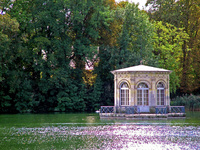 Chateau de Fontainebleau
Chateau de Fontainebleau
Chateau de Fontainebleau »
Once, Fontainbleau had the noblest garden in France. It was made for a king, Francois I, who wished to rival the great courts of Italy. Though the old knots and statuary have gone, enough of the 1528-1547 layout survives to give one a sense of how gardens were arranged in sixteenth century France. Francois had led an army into Italy and admired the gardens. He attracted Italian artists to France, including Leonardo da Vinci, and fostered Renaissance culture north of the Alps. The large trapezoid pond, formerly used for aquatic displays, survives. It now has a banqueting pavilion on an island. The pond was shaped by the landform and formed a starting point for the design. The Cour de la Fontai.....
Read more on Chateau de Fontainebleau
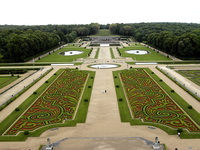 Chateau de Vaux-le-Vicomte
Chateau de Vaux-le-Vicomte
Chateau de Vaux-le-Vicomte »
The most elegant and geometrically harmonious of all high Baroque gardens. Vaux was designed, before Versailles, by Andre le Nôtre and Louis II le Vau. The composition is perfectly proportioned and soothingly harmonious, with the gardens organised on a central axis. The axial principle derives from Bramante and was recommended by Andre Mollet. At Vaux, the axis passes through parterres, over basins of water, and into forests. Brilliant use of the landform allows many surprises. Yet the composition is balanced from every point of view. The garden was laid out for a rich financier, Fouquet, and had many statues which Louis XIV removed after casting the owner into jail for being overly amb.....
Read more on Chateau de Vaux-le-Vicomte
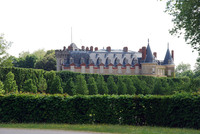 Château de Rambouillet
Château de Rambouillet
Château de Rambouillet »
A great Baroque hunting chateau with radiating canals and avenues. It has been the summer residence of the French Presidents since 1896.
Read more on Château de Rambouillet
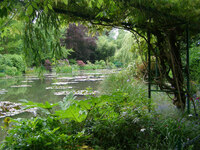 Giverny, Fondation Claude Monet
Giverny, Fondation Claude Monet
Giverny, Fondation Claude Monet »
An atmospheric country garden planted and painted by the leading spirit of French impressionism, Claude Monet. The artist moved from Paris to Giverny in 1883, believing that all painting of nature should be finished 'on the spot', not in a comfortable studio. In the same spirit, Repton had argued that landscapes should be designed 'on the spot', not in a drawing office. Giverny has two parts. Near the house is a traditional Normandy clos, a Walled Garden for vegetables and fruit. Monet placed arches over the paths and intermixed flowers with the fruit trees. In the nineteenth century manner, he favoured brightly coloured annuals, herbaceous perennials and shrubs. He planted Japanese cherries,.....
Read more on Giverny, Fondation Claude Monet
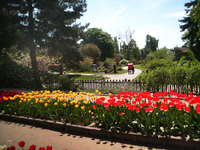 Parc Floral de Paris
Parc Floral de Paris
Parc Floral de Paris »
A modern park on the ancient royal estate of Vincennes. The park was created as part of a garden festival in 1966 and retains many display features and floral collections.
Read more on Parc Floral de Paris
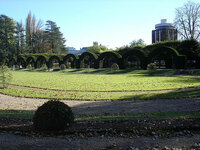 Prés Fichaux Jardin
Prés Fichaux Jardin
Prés Fichaux Jardin »
This garden in the heart of Bourges was designed by Paul Margueritta. It has an art deco 'architectural character' but the 'buildidng material' is green hedging. It has a rosary, an open-air theatre, water basins and notable sculpture.
Read more on Prés Fichaux Jardin
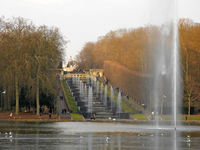 Sceaux
Sceaux
Sceaux »
Le Nôtre designed the garden with two great axes meeting sat at rightangles on the hill-top chateau. From the garden front of the chateau, a leading perspective runs westwards into a valley and up the opposite hill. At the dip point, one finds a broad canal in the valley bottom. Sceaux was deserted during the revolutionary years. In the ninetenth century, an under-sized new chateau was built and the gardens were restored with some modifications. Today the garden is well-maintained and has a interesting network of avenues, canals and basins. From the east front of the chateau, a stepped cascade crashes down the axis into a great oxagon pool. Had Sceaux been in England, Brown should surel.....
Read more on Sceaux